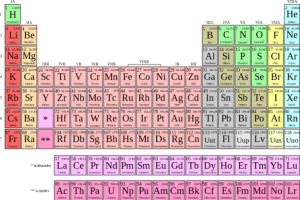Playlist
Show Playlist
Hide Playlist
Atomic Structure – Chemistry
-
Slides 02 Chemistry CellBiology.pdf
-
Reference List Molecular and Cell Biology.pdf
-
Download Lecture Overview
00:00 So first, let's take a look at general atomic structure. We have protons, neutrons, electrons. 00:08 You've probably all heard of those. 00:10 To review protons and neutrons, they're found in the nucleus of an atom. 00:14 And electrons are found in the periphery. Protons and neutrons have some mass. 00:21 And electrons have barely any mass at all, which is why they float around essentially in electron cloud around the central nucleus of protons and neutrons. 00:34 Protons are found in the nucleus. They're positively charged and they weigh one atomic mass unit. 00:44 Neutrons are also found in the nucleus and weigh one atomic mass unit whereas electrons weigh barely anything. Their weight is essentially negligible. 00:57 And they're found in a cloud surrounding the protons and neutrons in the nucleus and have a negative charge. 01:04 So proton's positive, electron's negative, neutrons neutral. 01:10 Atomic number is what defines an element. So let's say we're looking at carbon, it has atomic number 6. 01:18 It means it has 6 protons. And any atom with 6 protons is called carbon. 01:25 We may see some variants in the number of neutrons and electrons, we'll take a look at some example shortly. 01:31 But atomic number definitely defined by the number of protons and that defines what the element is called. 01:39 We have also atomic mass. When we add the protons and the neutrons in the nucleus together, that gives us the atomic mass. 01:47 Again, each of them is one atomic mass unit, and thus our atomic mass for standard carbon, the most prevelant form of carbon is 12 atomic mass units. 01:58 As I mentioned, we could have a varying number of neutrons. They are less common forms. 02:04 But isotopes are the name we gave for a varying numbers of neutrons. 02:09 Again, here we have carbon. It has 6 protons. It will always have 6 protons. 02:14 But we could have carbon-13, which you've probably heard of in carbon dating. Carbon-14. 02:21 We have 6 protons. We subtract that from 13 means we have 7 neutrons. 02:27 We might even see in variant instances, carbon-14, in which case we actually have 8 neutrons and the atomic mass of 14. 02:39 We can also see variation in electrons. When we have either more or less electrons, we have ions. 02:47 For example, if we look at sodium, in its natural state, we have a balanced number of electrons and protons. 02:55 However, we'll often see sodium as a postive ion, so Na+, in which case we have one less electron We take away a negative charge, but we still have the same number of positive charges, so we end up with a positive ion. 03:13 In the example below we see, we have chlorine. Chlorine is in its balanced state where we have equal number of electrons and protons. 03:22 However chlorine sometimes likes to gain an electon, in which case we have an additional negative charge and so there's not balance, we'll see Cl-. 03:33 And we'll see later in the next lecture, how sodium and chloride might interact with each other because of these positive and negative charges. 03:43 So once again, to emphasize, proton number is not going to change, at least in biology. 03:50 And proton number is going to define what element we're looking at.
About the Lecture
The lecture Atomic Structure – Chemistry by Georgina Cornwall, PhD is from the course Introduction to Cell Biology.
Included Quiz Questions
What defines the atomic number of an element?
- Number of protons
- Number of electrons
- Number of neutrons
- Number of both protons and neutrons
- Number of both protons and electrons
Which term is correctly matched with its definition?
- Isotopes – two or more atoms of an element having the same atomic number but a different number of neutrons
- Ions – elements with the same atomic number but a different number of neutrons
- Atomic mass – the number of protons in the nucleus
- Nucleus – neutrons plus electrons in the center of an atom
- Proton – a negatively charged particle moving around the nucleus
Customer reviews
5,0 of 5 stars
| 5 Stars |
|
5 |
| 4 Stars |
|
0 |
| 3 Stars |
|
0 |
| 2 Stars |
|
0 |
| 1 Star |
|
0 |




